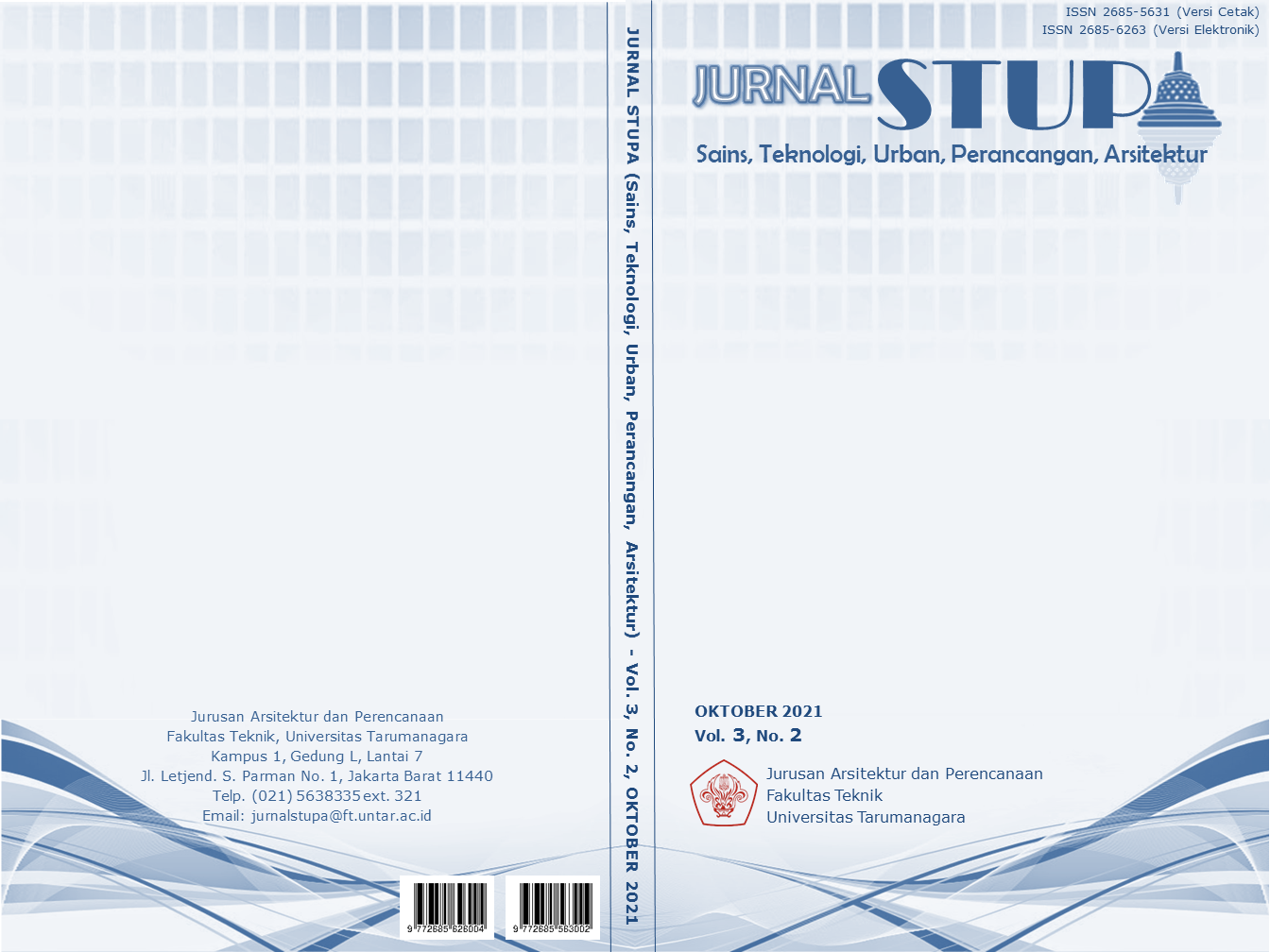HYBRID PROGRAM REKREASI DAN PENGOLAHAN SAMPAH MAKANAN BERBASIS MASYARAKAT
Main Article Content
Abstract
The current global phenomenon, Covid-19 pandemic, encourages people to change their lifestyles. Some of them are studying, working, and doing activities from home. And then this can cause a reaction in the form of panic buying in adapting. In the process, humans began to use e-commerce which then had a significant impact on increasing waste. This increasing happens because there's a reciprocal relationship between humans and their environment or commonly called ecology. But long before that, the waste problem has not been resolved due to the lack of public awareness. People don't have a responsible attitude towards the waste that they produced. In particular, food waste occupies the highest percentage of global wastes. But this contrasts with the fact that 8.9% of the world's population is still hungry. It is not only an economic and global warming problem, but this also consumes limited natural resources in the environment. The layering diagram method (Sutanto, 2020) is applied to create responsible waste management. It is related to the analysis of potential, needs, site, and activities. And for the distribution of the program is based on the Food Recovery Hierarchy (USEPA, 2020) related to reduce, reuse, and recycle. The application of this method then produces a hybrid program in the form of recreation and processing. Collaboration extends the life cycle of waste in the community activity space providing an opportunity to play a role. The existence of spaces for gathering, discussing, processing, and planting, is the embodiment of the hybrid program. In addition, the process is also collaborated by the role of technology as part of future processing.
Keywords: ecology; food waste; reduce; reuse; recycle.
Abstrak
Fenomena global yang terjadi saat ini yakni pandemi Covid-19, mendorong manusia untuk mengubah gaya hidupnya. Beberapa diantaranya ialah belajar, bekerja, dan beraktifitas dari rumah. Hal ini kemudian menimbulkan reaksi berupa panic buying dalam beradaptasi. Dalam prosesnya, manusia mulai berkembang ke penggunaan e-commerce yang kemudian memberikan dampak cukup signifikan pada peningkatan sampah. Ini merupakan hubungan timbal balik antara manusia dengan lingkungannya atau biasa disebut ekologi. Namun jauh sebelum itu permasalahan sampah memang belum terselesaikan akibat minimya kesadaran masyarakat untuk memiliki sikap bertanggung jawab terhadap sampah yang dihasilkan. Khususnya sampah makanan yang menduduki persentase tertinggi dan juga kontras dengan kenyataan bahwa 8.9% dari populasi dunia masih kelaparan. Hal ini menjadi penting karena sampah makanan bukan hanya masalah ekonomi dan pemanasan global, namun juga menghabiskan sumber daya alam yang terbatas di lingkungan. Dengan tujuan untuk menciptakan pengolahan sampah yang bertanggungjawab, maka diterapkan metode diagram layering (Sutanto, 2020) terkait analisis potensi, kebutuhan, tapak, dan aktifitas. Serta pembagian programnya di dasari oleh Food Recovery Hierarcy (USEPA, 2020) terkait reduce, reuse, dan recycle. Penerapan metode ini kemudian menghasilkan hybrid program berupa rekreasi dan pengolahan. Kolaborasi memperpanjang siklus hidup sampah dalam ruang kegiatan masyarakat memberikan kesempatan untuk berperan. Hal ini diwujudkan dengan adanya ruang – ruang untuk berkumpul, berdiskusi, mengolah, dan menanam. Selain itu prosesnya juga dibantu dengan peran teknologi sebagai bagian dari pengolahan masa depan.
Article Details
Section
References
Anindita, L. (2018, April 9). Sampah di Desa Citarik Kini Terkelola Baik Dengan TPS 3R. Dipetik Agustus 11, 2021, dari merdekanews.co: https://m.merdekanews.co/read/3025/Sampah-di-Desa-Citarik-Kini-Terkelola-Baik-dengan-TPS-3R
Arendt, H. (1958). The Human Condition. United States: University of Chicago Press.
Badan Penelitian dan Pengembangan Kementrian Dalam Negeri. (2018, April 26). Riset: 24 Persen Sampah di Indonesia Masih Tak Terkelola. Dipetik March 18, 2021, dari Badan Litbang Kemendagri: http://litbang.kemendagri.go.id/website/riset-24-persen-sampah-di-indonesia-masih-tak-terkelola/
Bratton, B. H. (2015). The Stack: On Software and Sovereignty. London: Massachusetts Istitute of Technology.
FAO, IFAD, UNICEF, WFP, WHO. (2020). The State of Food Security and Nutrition in the World 2020. Rome: FAO, IFAD, UNICEF, WFP and WHO.
Gorter, H. d., Drabik, D., Reynolds, C., & Quested, T. (2020). Addressing Food Loss and Waste: A Global Problem with Local Solutions. World Bank Group, 129.
McDonough, W., & Braungart, M. (2002). Cradle to Cradle: Remaking the Way We Make Things. New York1: North Point Press.
Odum, E. P., & Barret, G. W. (1971). Fundamentals of Ecology (3rd ed.). London: W.B. Sounders company.
Repository University of Riau. (t.thn.). Repository University of Riau. Dipetik Maret 18, 2021, dari Repository University of Riau: https://repository.unri.ac.id/bitstream/handle/123456789/7151/4.BAB%20II.PDF?sequence=4&isAllowed=y
Sutanto, A. (2020). Peta Metode Desain (3rd ed.). Jakarta: Universitas Tarumanagara.
UBS. (2020, February 24). Future of Waste Part 1: Types, Sources and Impact. Dipetik March 18, 2021, dari UBS Chief Investment Office: https://www.ubs.com/global/en/wealth-management/chief-investment-office/investment-opportunities/investing-in-the-future/future-of-waste/2020/future-of-waste-part1.html
USEPA. (2020, December 31). Sustainable Management of Food. Dipetik March 18, 2021, dari United States Environmental Protection Agency: https://www.epa.gov/sustainable-management-food/food-recovery-hierarchy
Van der Ryn, S., & Cowan, S. (1996). Ecological Design (10th ed.). Washington: Island Press.

